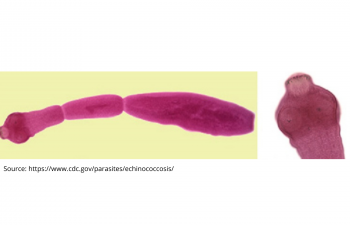
Parasitic Zoonoses
When a parasite that usually resides inside or on an animal’s body causes a disease in human beings, the disease caused by it is known as parasitic zoonosis. There are many types of parasites that reside in and on animals’ bodies. Pet animals like dogs and cats also have them and can become an important source of transmission of these parasites to humans if not taken good care of.

Echinococcosis
This is a disease caused by the tapeworms of Echinococcus spp. Echinococcosis can be of two types, cystic echinococcosis and alveolar echinococcosis.
Cystic echinococcosis (Hydatid disease) is caused by E. granulosus in their larval stage. It is 2-7 mm tapeworm and its definitive hosts are dogs. Human cases of CE are less and usually asymptomatic. Alveolar echinococcosis is caused by E. multilocularis in its larval stage. It is a 1-4 mm long tapeworm and its definitives hosts are foxes, coyotes and dogs. AE cases in humans are also scarce but they are more harmful than CE.
CE is usually found in western regions of China, Central Asia, South America, Mediterranean countries and Eastern Africa. The main risk factors are contact with dogs and livestock. AE is usually found in northern Japan, China and Tibet. Human cases of Ae are also found in European countries.
CE is endemic in India. Highest prevalence is present in Tamil Nadu and Andhra Pradesh. The annual incidence of CE according to a survey is 1-200 in every 1000000 people.
More details on the epidemiology for CE and AE can be found on
https://reader.elsevier.com/reader/sd/pii/S1995764512600352?token=5BD667789639B97D6F6D14584263566DBC141A5BFC1F9B047CDB8C928A8C2DCEA00A9AA0D95A084E7C4694D5B30CDC36&originRegion=eu-west-1&originCreation=20210813142006
The adult tapeworm E. granulosus lives in the bowels of dogs or other canines. They release eggs which come out with the feces. These eggs are then ingested by intermediate hosts like sheep, goats or swine, etc. These eggs then hatch and release oncosphere. This oncosphere penetrates through the intestine and goes to other organs like lungs and liver and forms a cyst like structure. The final host gets infected by consuming the organs of the intermediate host. Humans in this case are mostly accidental hosts.
In humans-
- The signs are variable depending on the size, site and condition of the cyst.
- Hepatic enlargement
- Pain
- Nausea
- Extreme weakness
- Weight-loss may occur.
- Anaphylactic reactions almost fatal in origin can be observed in case a cyst bursts inside the body.
In animals-
Most animals are asymptomatic because the worms remain confined to the intestine. Hydatid cysts are developed on liver, heart and lungs.
In rare cases, tapeworms may be seen around the rectum of animals. In humans, X-rays, USGs,
CT Scans, MRI and blood tests are done for the diagnosis of Echinococcosis. It is very difficult to
differentiate Echinococcus eggs from the eggs of other worms.
Ideally, this disease can be prevented by regularly deworming pet animals. If hygiene standards are maintained, the chances of this disease are less. Regular washing of hands, eating in sanitary places, eating away from animals presence are all basic steps that one can take to prevent this disease. At animal farms, dogs are important reservoirs and transmitters. Thus prevent animal feed and fodder from being contaminated with dog feces. At slaughter houses, avoid throwing inedible parts of carcasses having cysts and do not allow dogs in the slaughter house premises. EG95 vaccine is available for intermediate hosts like sheep. This vaccine can be used in field conditions. Elimination of older sheep is also a procedure that can help to prevent this disease.
Sources:
- https://onlinelibrary.wiley.com/doi/abs/10.1111/zph.12649
- https://reader.elsevier.com/reader/sd/pii/S1995764512600352?token=5BD667789639B97D6F6D14584263566DBC141A5BFC1F9B047CDB8C928A8C2DCEA00A9AA0D95A084E7C4694D5B30CDC36&originRegion=euwest-1&originCreation=20210813142006
- https://www.ijidonline.com/article/S1201-9712(08)01440-9/fulltext
- https://www.cdc.gov/parasites/echinococcosis/gen_info/ae-faqs.html
